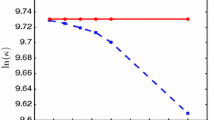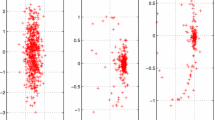Abstract
This paper explores the use of polynomial preconditioned CG methods for hermitian indefinite linear systems,Ax=b. Polynomial preconditioning is attractive for several reasons. First, it is well-suited to vector and/or parallel architectures. It is also easy to employ, requiring only matrix-vector multiplication and vector addition. To obtain an optimum polynomial preconditioner we solve a minimax approximation problem. The preconditioning polynomial,C(λ), is optimum in that it minimizes a bound on the condition number of the preconditioned matrix,C(A)A. We also characterize the behavior of this minimax polynomial, which makes possible a thorough understanding of the associated CG methods. This characterization is also essential to the development of an adaptive procedure for dynamically determining the optimum polynomial preconditioner. Finally, we demonstrate the effectiveness of polynomial preconditioning in a variety of numerical experiments on a Cray X-MP/48. Our results suggest that high degree (20–50) polynomials are usually best.
Similar content being viewed by others
References
L. M. Adams.Iterative algorithms for large, sparse linear systems on parallel computers. PhD thesis, Univ. of Virginia, Applied Mathematics, 1982.
L. M. Adams.M-step preconditioned conjugate gradient methods. SIAM J. Sci. Stat. Comput., 6(2):452–463, 1985.
R. S. Anderssen and G. H. Golub.Richardson's non-stationary matrix iterative procedure. Technical Report 304, Stanford University, Dept. of Computer Science, 1972.
S. F. Ashby.Polynomial preconditioning for conjugate gradient methods. PhD thesis, Univ. of Illinois at Urbana-Champaign, Dept. of Computer Science, December 1987. Available as Technical Report 1355.
S. F. Ashby and T. A. Manteuffel.Adaptive polynomial preconditioning for HPD matrices. In preparation.
S. F. Ashby, T. A. Manteuffel, and P. E. Saylor.A taxonomy for conjugate gradient methods. Technical Report UCRL-98508, Lawrence Livermore National Laboratory, 1988.
B. Atlestam.Tschebyscheff-polynomials for sets consisting of two disjoint intervals with application to convergence estimates for the conjugate gradient method. Technical Report 77.06R, Dept. Computer Sciences, Chalmers University of Technology and the University of Goteborg, Sweden, 1977.
O. Axelsson.A class of iterative methods for finite element equations. Comput. Methods Appl. Mech. Eng., 9(2):123–137, 1976.
O. Axelsson.A survey of preconditioned iterative methods for linear systems of algebraic equations. BIT, 25:166–187, 1985.
P. N. Brown and A. C. Hindmarsh.Matrix-free methods for stiff systems of ODE's. SIAM J. Numer. Anal., 23(3):610–638, 1986.
J. R. Bunch and B. N. Parlett.Direct methods for solving symmetric indefinite systems of linear equations. SIAM J. Numer. Anal., 8:639–655, 1971.
T. F. Chan, C. J. Kuo, and C. Tong.Parallel elliptic preconditioners: Fourier analysis and performance on the Connection Machine. Technical Report CAM 88-22, Univ. of California, Los Angeles, Dept. of Mathematics, 1988.
R. Chandra, S. C. Eisenstat, and M. H. Schultz.The modified conjugate residual method for partial differential equations. In R. Vichnevetsky, editor,Advances in Computer Methods for Partial Differential Equations II, pages 13–19, 1977.
E. W. Cheney.Introduction to Approximation Theory. McGraw-Hill, New York, 1966.
A. Chronopoulos.A class of parallel iterative methods implemented on multiprocessors. PhD thesis, Univ. of Illinois at Urbana-Chanpaign, Dept. of Computer Science, November 1986. Available as Technical Report 1267.
A. T. Chronopoulos and C. W. Gear.Implementation of s-step methods on parallel vector architectures. Technical Report 1346, Univ. of Illinois at Urbana-Champaign, Dept. of Computer Science, June 1987.
P. Concus, G. H. Golub, and D. P. O'Leary.A generalized conjugate gradient method for the numerical solution of elliptic partial differential equations. In J. R. Bunch and D. J. Rose, editors,Sparse Matrix Computations, pages 309–332. Academic Press, New York, 1976.
G. Dahlquist and A. Björck.Numerical Methods. Prentice-Hall, Englewood Cliffs, NJ, 1974.
C. de Boor and J. R. Rice.Extremal polynomials with application to Richardson iteration for indefinite linear systems. SIAM J. Sci. Stat. Comput., 3(1):47–57, 1982.
P. F. Dubois, A. Greenbaum, and G. H. Rodrigue.Approximating the inverse of a matrix for use on iterative algorithms on vector processors. Computing, 22:257–268, 1979.
V. Faber and T. A. Manteuffel.Necessary and sufficient conditions for the existence of a conjugate gradient method. SIAM J. Numer. Anal., 21(2):352–362, 1984.
R. Freund.Private communication. Los Alamos National Laboratory, Los Alamos, NM, 1986.
P. Gill, W. Murray, and M. Saunders.Preconditioning indefinite systems with the Bunch-Parlett factorization. SIAM Symposium on Sparse Matrices, Gleneden Beach, OR, 1989.
G. H. Golub and M. D. Kent.Estimates of eigenvalues for iterative methods. Math. Comp., 53(188), 1989.
G. H. Golub and C. F. Van Loan.Matrix Computations. The Johns Hopkins University Press, Baltimore, MD, 1983.
J. F. Grcar.Analyses of the Lanczos algorithm and of the approximation problem in Richardson's method. PhD thesis, Univ. of Illinois at Urbana-Champaign, Dept. of Computer Science, December 1981. Available as Technical Report 1074.
J. F. Grcar.Private communication. Livermore, CA, 1987.
L. A. Hageman and D. M. Young.Applied Iterative Methods. Academic Press, New York, 1981.
M. R. Hestenes and E. Stiefel.Methods of conjugate gradients for solving linear systems. J. Research of NBS, 49:409–435, 1952.
O. G. Johnson, C. A. Micchelli, and G. Paul.Polynomial preconditioning for conjugate gradient calculations. SIAM J. Numer. Anal., 20(2):362–376, 1983.
T. L. Jordan.Conjugate gradient preconditioners for vector and parallel processors. In G. Birkhoff and A. Schoenstadt, editors,Proceedings of the Conference on Elliptic Problem Solvers, New York, 1984. Academic Press.
V. I. Lebedev,Iterative methods for the solution of operator equations with their spectrum lying on several intervals. Zhur. Vych. Mat. i Mat. Fiz., 9(6):1247–1252, 1969. An English translation appears in Anderssen-Golub (1972).
J. A. Meijerink and H. A. van der Vorst.An iterative solution method for linear systems of which the coefficient matrix is a symmetric M-matrix. Math. Comp., 31(137):148–162, 1977.
P. D. Meyer, A. J. Valocchi, S. F. Ashby, and P. E. Saylor.A numerical investigation of the conjugate gradient method as applied to three-dimensional groundwater flow problems in randomly heterogeneous porous media. Water Resources Research, 25(6):1440–1446, 1989.
J. S. Otto.Private communication. Denver, CO, 1989.
C. C. Paige and M. A. Saunders.Solution of sparse indefinite systems of linear equations. SIAM J. Numer. Anal., 12(4):617–629, 1975.
B. N. Parlett.The Symmetric Eigenvalue Problem. Prentice-Hall, Englewood Cliffs, N.J., 1980.
Y. Saad.Practical use of polynomial preconditionings for the conjugate gradient method. SIAM J. Sci. Stat. Comput., 6(4):865–881, 1985.
P. E. Saylor.Leapfrog variants of iterative methods for linear algebraic equations. J. Comp. & Applied Math., 24:169–193, 1988.
D. M. Young and K. C. Jea.Generalized conjugate gradient acceleration of nonsymmetrizable iterative methods. Linear Algebra Appl., 34:159–194, 1980.
Author information
Authors and Affiliations
Additional information
This research was supported in part by the Applied Mathematical Sciences subprogram of the Office of Energy Research, U.S. Dept. of Energy, by Lawrence Livermore National Laboratory under contract W-7405-ENG-48.
This research was supported in part by the Dept. of Energy and the National Science Foundation under grant DMS 8704169.
This research was supported in part by U.S. Dept. of Energy grant DEFG02-87ER25026 and by National Science Foundation grant DMS 8703226.
Rights and permissions
About this article
Cite this article
Ashby, S.F., Manteuffel, T.A. & Saylor, P.E. Adaptive polynomial preconditioning for hermitian indefinite linear systems. BIT 29, 583–609 (1989). https://doi.org/10.1007/BF01932736
Received:
Revised:
Issue Date:
DOI: https://doi.org/10.1007/BF01932736




